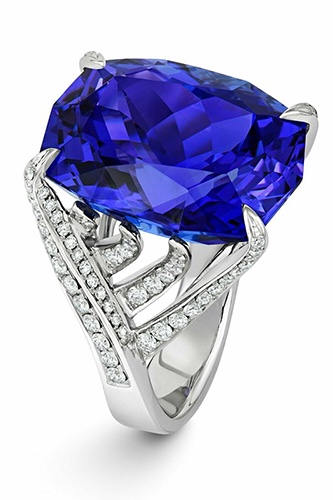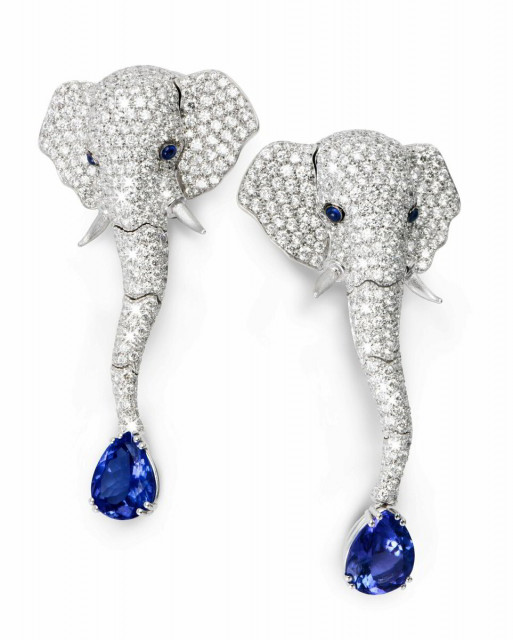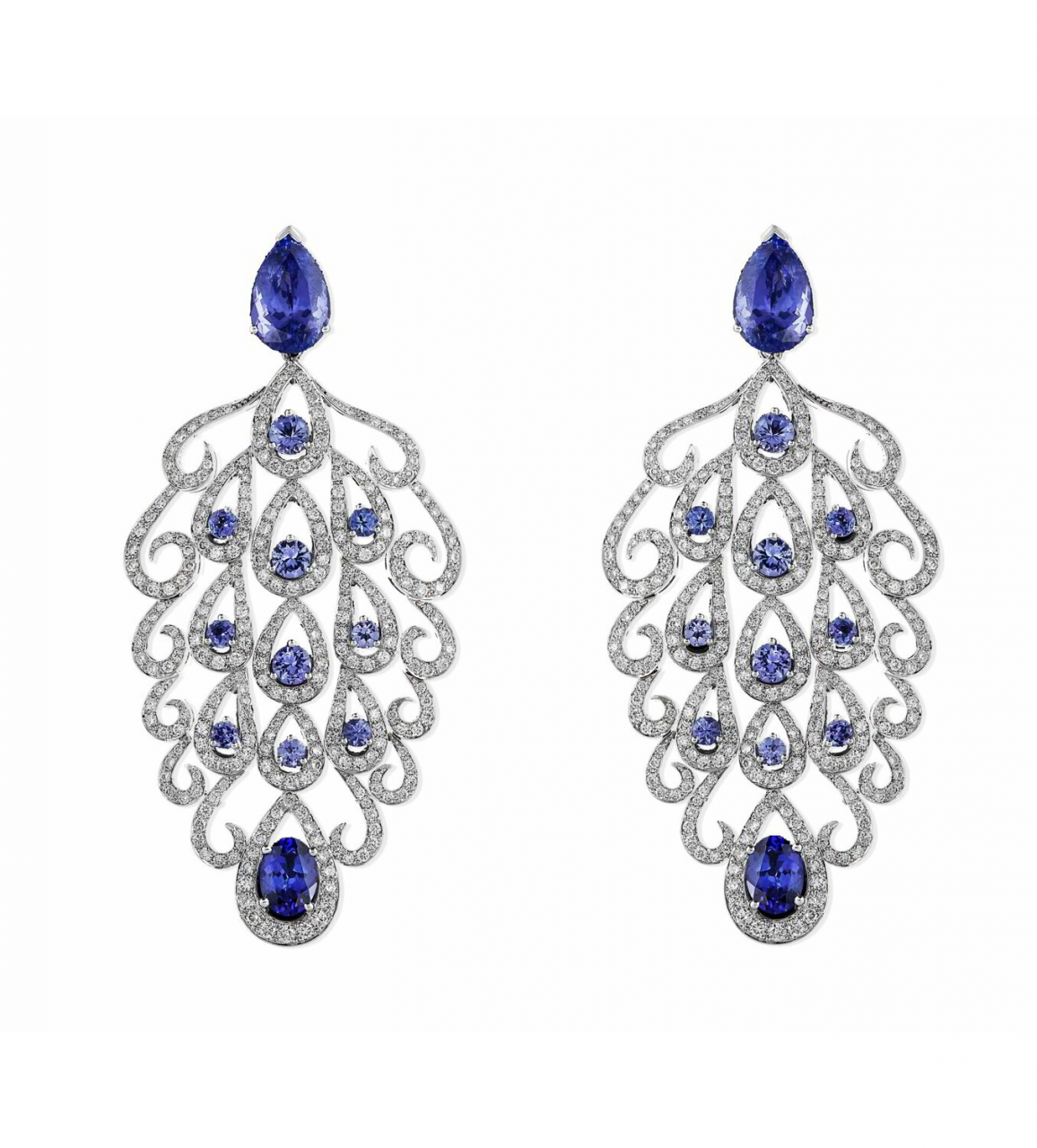Julia's Blog
Tanzanite
Tanzanite is the exquisite blue- purple variety of the mineral zoisite that is only found in one part of the world.
Tanzanite may be a relative newcomer to the world of colored stones, but it was one of the most exciting gem discoveries of the 20th century. Blue stones emerging from Tanzania were identified as the mineral zoisite in 1962.
Not until 1967, though, did prospectors locate the primary source for this December birthstone: the Merelani Hills. It was eventually named tanzanite in honor of its country of origin. The tanzanite birthstone is often described as "velvety," mostly because of its deep and saturated color, which ranges from a pure rich blue to violet, with the blue considered most valuable.
With its vivid colors, high clarity and potential for large cut stones, tanzanite quickly became a sensation. Today, it is not only a December birthstone, but it is also the gem for the 24th wedding anniversary.
A more common version of the story claims that the first specimens of the stone were found by a merchant from Portugal, Manuel d'Souza. In the East African state, a man was taken to search for rubies. He wandered around the country with an expedition of representatives of the local Maasai tribe, until he came across a nondescript brown and purple stone on the Merelani plateau. Manuel took the find for a sapphire, but after checking it turned out to be a kind of ziosite,far from jewelry.
Another version of the story attributes the discovery of the Tanzanian mineral to the shepherd of the aforementioned tribe, Ali Juyawati. He discovered the nugget after a fire on a plateau, when the fire destroyed the top layer of the soil.
Ali took the find to d'Souza himself, but the ruby dealer considered it useless.
Over the next year, the mystical tanzanite stone remained in the margins of the jewelry industry, and then luck smiled at him. Henry Plath (vice president of the Tiffany jewelry house) became interested in the mineral. It was he who gave the name to the stone and began to use it to create exquisite jewelry.
The stone has many amazing qualities. The most interesting of them is pleochroism - the ability to change shades depending on the viewing angle. This means that if you look at tanzanite from different angles, the colors appear different.
Some samples boast an alexandrite effect. In daylight, they appear blue, while indoors they change to purple. There are also specimens with the effect of a cat's eye, inside which you can see a luminous strip. Most often tanzanite is found in the form of not the most beautiful brown-brown nuggets. Of course, no one uses such minerals - they are heated to get a richer shade.
Due to pleochroism, tanzanite can display different colors when viewed from different angles. Stones must be cut properly to highlight the more attractive blue and violet hues and deemphasize the undesirable brown tones.
Most of the tanzanite on the market today is heat treated to minimize the brown colors found naturally and to enhance the blue shades that can rival sapphire.
Tanzanite is still only found on a few square miles of land in Tanzania, near majestic Mount Kilimanjaro. Its price and availability are directly tied to mines in this region, most of which are now slowing production significantly.
Tanzanite measures 6.5 to 7 on the Mohs scale of hardness
which is not nearly as hard as the sapphire it often substitutes. Given its vulnerability to scratch during daily wear and abrasion, tanzanite is better suited for earrings and pendants than rings.
Between its deep blue color and its limited supply, tanzanite is treasured by many, even if your birthday is not in December.
Tanzanite History
Unlike many well-known gemstones that have been in use for centuries, tanzanite's history is relatively modern.
The common story of tanzanite's discovery tells of Maasai herders who found blue crystals in the Merelani Hills near Arusha, Tanzania, while tending livestock in 1967. They notified a prospector named Manuel d'Souza, who promptly registered claims with the government to begin mining.
Initially, d'Souza thought he was mining sapphire gems, but the crystal was soon identified as a vibrant blue variety of zoisite—a mineral stone that had been around since the early 1800s.
Tiffany & Co. recognized this blue gem's potential to rival more expensive sapphire and agreed to become its main distributor. Instead of publicizing "blue zoisite"—which sounded a little too much like "suicide"—Tiffany named the gemstone "tanzanite" to highlight its exclusive geographic origin. They introduced it with a promotional campaign in 1968.
An estimated two million carats of tanzanite were mined
before the Tanzanian government nationalized the mines in 1971. The government divided the mines into four sections, or blocks, in 1990. Tanzanite One Mining Ltd., the world's largest tanzanite producer, holds the rights to Block C, which is larger than the other blocks combined.
An independent study from 2012 suggests that at a production rate of 2.7 million carats per year, Block C's tanzanite deposits may deplete in as soon as 30 years.
Tanzanite may not have the long history of other gemstones, but with such limited supplies and rapidly growing popularity, it is highly prized for its rare beauty.
Usually all found tanzanites are divided into two large groups - blue and purple. For the leading shade, respectively, the concentration of chromium and vanadium is responsible.
But this does not mean that the palette of the mineral ends with only 2 varieties. In some deposits you can find large stones of greenish or lilac shades. Less common are pink, lavender, transparent and even white minerals. Most often, tanzanite combines several colors at once, which can be seen from different angles.
The magic of the mineral is very useful for resolving some conflicts and strengthening relationships. The stone, as it were, compensates for its natural fragility and seeks to unite people.
The power of the amulet is most clearly expressed in the following:
The gift of clairvoyance. Not a single beginner or even an experienced psychic will refuse such an acquisition. The thing is that the stone enhances intuition. If a person is endowed with the talent of clairvoyance from birth, the mineral will maximize his abilities and help predict the future. The stone will help ordinary people avoid many troubles and choose the right path. The main thing is to listen to your feelings.
No conflicts. There are practically no quarrels around tanzanite. Around itself and its owner, the stone creates an atmosphere of warmth, comfort, tranquility. All misunderstandings are resolved through negotiations. There will be no gossip or intrigue among colleagues, and the group of friends will become more cohesive.
Love symbol. If you are having any problems with the opposite sex, be sure to look for tanzanite jewelry. Paying the attention of a beloved or kindling a volcano of passions - this mineral can do it.
Money magnet. Success and financial well-being await the owner of the stone. Unfortunately, money will not fall from the sky - tanzanite does not like the lazy. A generous reward awaits only those who have worked hard.
Help in choosing. This mineral will always tell you which path is better to choose. This is especially true for those who have not yet decided on the type of activity or doubt their decision.
Tanzanite jewelry should be worn at some important and important events. It will help you get out of trouble and give you confidence.
How to buy Tanzanite
The mineral can be worn by absolutely all signs of the zodiac - it will not harm anyone.
that a tanzanite amulet can give. The gem will share its wisdom with them and teach them to make the right decisions.
Others are of the opinion that the favorites of the stone are the signs of Air - Gemini, Libra, Aquarius. But the mineral acts on them in a completely different way, helping to make a choice. Creative and multifaceted air signs often fail to find their way, which prevents them from achieving success. For them, an amulet with tanzanite will become a navigator in life, which will lead to the desired result much faster and easier.
The stone has an interesting meaning in the life of the Water signs. Pisces, Cancer and Scorpio are too sensitive to all the quarrels that happen next to them. Tanzanite will give them complete peace of mind and relieve them of mental anguish, which will definitely lead to positive changes in their lives.
Everyone knows that Earth signs are real workaholics who, in the heat, can forget absolutely everything. It would seem that with such a pathological love for your work, you can not even hope to save your family. But the amulet will strengthen the family relationship of Taurus, Virgo and Capricorns and will not allow them to forget about their profession.
This December birthstone (6 to 7 on the Mohs scale of harness) is resistant to the effects of normal heat, light and common chemicals. Still, the December birthstone may crack if exposed to very high temperatures or sudden temperature changes, and it abrades easily. It can be attacked by hydrochloric and hydrofluoric acids.
Most tanzanite begins as brownish zoisite that is heat treated to produce the blue to violet hues that characterize this December birthstones. The resulting color is permanent, and there are no additional durability concerns.
Your tanzanite birthstone is best set in earrings or pendants. While not recommended for daily wear in a ring, with a protective mounting and some care this December birthstone can be an attractive special-occasion jewel.
Warm, soapy water is the best way to clean this December birthstone. Ultrasonic and steam cleaners recommended for tanzanite.
There are many reasons to buy tanzanite, whether to celebrate a December birthday, to commemorate a 24th wedding anniversary, or simply to enjoy the gemstone's rare, vibrant blue. It even serves as a less expensive substitute for sapphire.
Most tanzanite on the market today gets its blue color from heat treatment, which minimizes the stone's natural brown hues. Treated tanzanite has become the norm, so although it's undetectable, it's usually assumed.
Generally, tanzanite follows the same value parameters as diamonds. Color, of course, is tanzanite's most prized trait, especially when it's deeply saturated blue with violet hues. Paler shades are less expensive.
Tanzanite is pleochroic, which means it displays different colors from different angles. The cut significantly influences the color, which determines the price. Cutting tanzanite to emphasize the blue may waste more of the rough, but because this color is more valuable than violet, the cutter may choose a small fine-colored blue gemstone over a larger violet one.
Most faceted tanzanite weighs less than five carats. Gemstones heavier than 50 carats are rare, although The Smithsonian Institution's collection includes a faceted 122.7-carat tanzanite. The world's largest rough tanzanite weighed 16,839 carats.
Because tanzanite gems are only found within a few square miles in Tanzania, their price and availability can fluctuate sharply, depending on what happens there.
Although it doesn't have a long history of admiration like some gemstones, tanzanite didn't take long to rise through the ranks. Between its exclusive origin, finite supply, and intense blue beauty, tanzanite continues to grow in popularity.
If you are looking for topaz birthstone jewelry, visit our high jewelery e-boutique where you can see a magnificent necklace with TANZANITE
Tanzanite & Diamond Necklace
18k solid white gold Tanzanite & Diamond Necklace, featuring genuine AAAA tanzanites 5,70 carats, natural white diamonds 1,34 carats VS2/F.
The color of the cut stone mainly depends on the cut. Tanzanite colors range from deep blue or violet to lighter shades.
The most attractive is the bright blue tanzanite, and therefore the jewelers try to enhance the blue shades when cutting.
Tanzanite is defined as "hue" or "color depth" by how light or dark it
has in color, from "Saturated" (AAA +) to "Dull" (A). The density of shades is an important criterion for the classification of tanzanite. By "density" is understood the degree of "filling" the stone with color.
Deep-colored tanzanite is more valuable because of its rarity. Larger stones tend to be darker in color. Tanzanites weighing less than 5 carats are usually not rich in shades.
Please get in touch with us and one of our experts will be able to assist you with all your tanzanite needs and beyond.
Your fashionably,
Julia
Comments
By accepting you will be accessing a service provided by a third-party external to https://juliacastelli.com/





